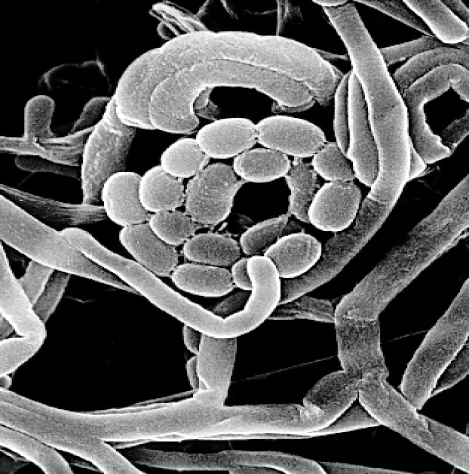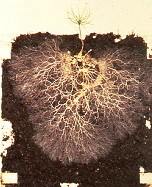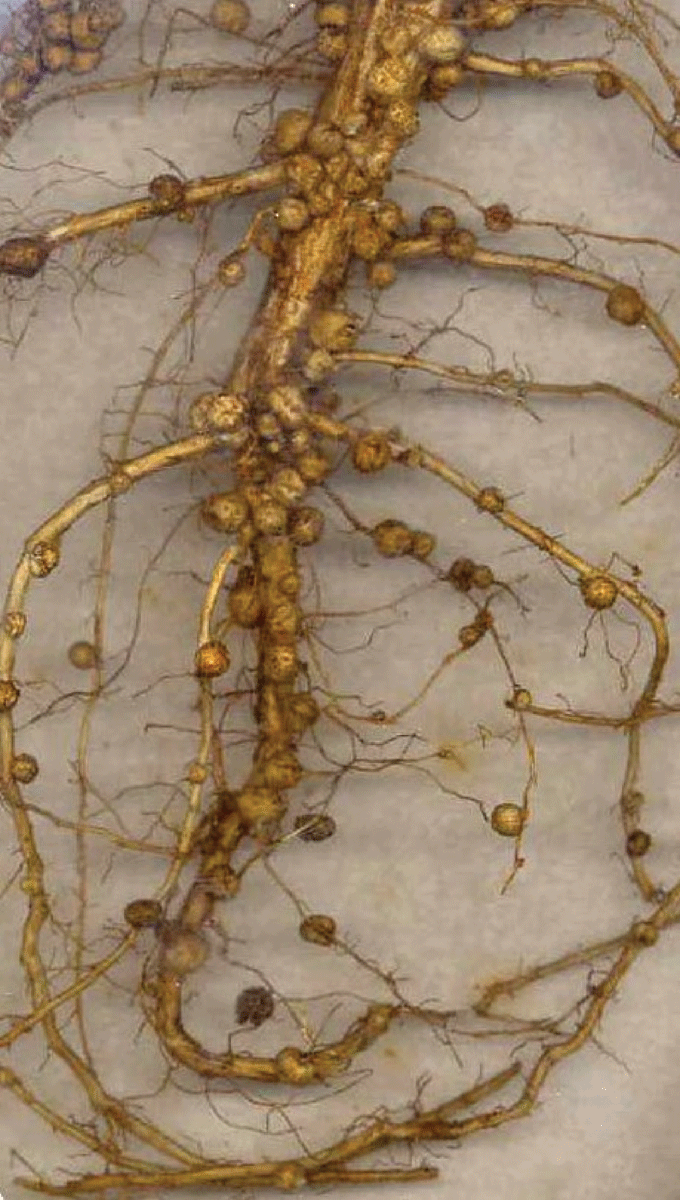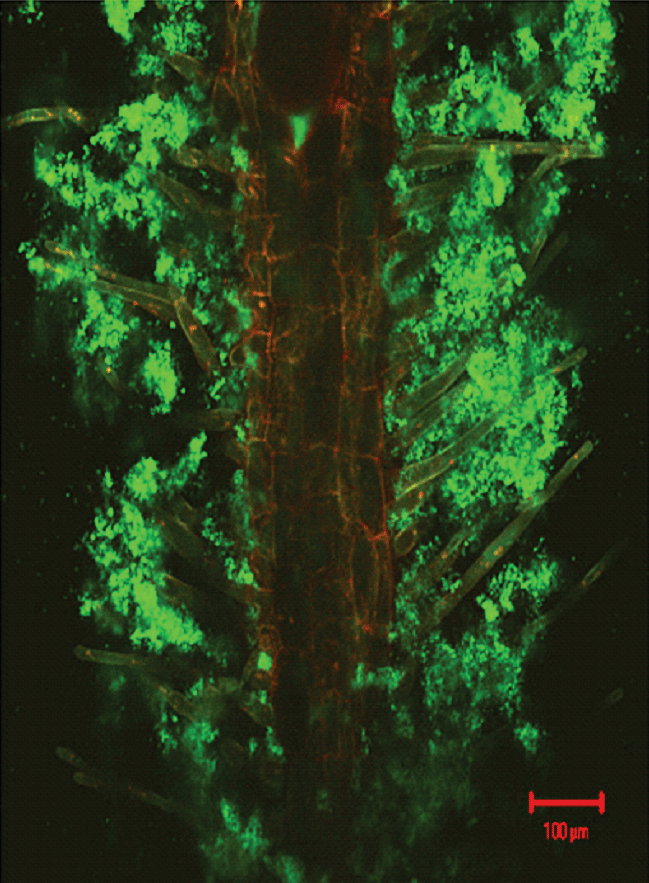Soil Biology
Soil biology is important for keeping agricultural systems healthy and productive. Living soil is complex. It includes creatures that cannot be seen with the naked eye, such as bacteria, fungi, actinomycetes, protozoa and nematodes, as well as creatures such as insects and earthworms. This community of organisms is bound together in a food web that affects the soil's chemical and physical properties. We care about these properties because they also affect plant growth and health.
 Microscopic actinomycetes in the soil. Some of these microorganisms produce antibiotics.
Microscopic actinomycetes in the soil. Some of these microorganisms produce antibiotics.Practices such as adding manures or composts to soil, planting cover crops and rotating crops are all aimed at rebuilding and maintaining soil organic matter, recycling and retaining nutrients, and decreasing soil diseases. These practices are usually associated with increased microbial biomass and increased soil organism diversity.
A healthy soil can contain billions of bacteria, fungi and other microorganisms in one teaspoon. Depending on soil conditions, the populations of these different microorganisms rise and fall. Some microbial populations increase quickly when fresh cover crops or other plant residues are added to the soil. For example, some microbes are able to use the readily available sources of carbon from fresh plant residues like humans use carbohydrates. These microbes decrease as the carbon sources are used up, causing other microbes that break down the less available sources of carbon like cellulose and lignin to increase. The point is that there are many native microorganisms in the soil that respond quickly when conditions are favorable for their growth.
Soil Inoculants
 These pine seedling roots are infected with mycorrhizal fungi that allow the plant to obtain nutrients from a bigger volume of soil.
These pine seedling roots are infected with mycorrhizal fungi that allow the plant to obtain nutrients from a bigger volume of soil.(David Read, Oregon State University)
As we continue to recognize that soil biology plays an important part in crop production, interest in soil inoculants continues to grow. Inoculants are used for a variety of reasons. In some cases, we add soil organisms that have a known beneficial effect. For example, some bacteria, like rhizobia, form a symbiotic relationship with certain host plants, like legumes. A symbiotic relationship is one that is mutually beneficial. In return for the plant feeding it carbon from photosynthesis and giving it a home, the bacteria can "fix" atmospheric nitrogen into a form that the plant can use. Some fungi, like mycorrhizae, can also form a symbiotic relationship with plants, scavenging phosphorus and other nutrients for the plant to use. Some bacteria and fungi do not form a symbiotic relationship with plants, but, when added to soil, can promote plant growth, suppress plant pathogens or both.
The easiest way to think about soil inoculants is to divide them according to their mode of action: biofertilizers or plant growth promoters, biopesticides and plant resistance stimulants.
Biofertilizers
Biofertilizers contain live microorganisms that, when applied to the seed, plant or soil, inhabit the area around the roots (rhizosphere) or live in the roots. These microorganisms promote plant growth by increasing the supply or availability of nutrients, by stimulating root growth or by aiding other beneficial symbiotic relationships. Biofertilizers are also called plant growth promoters.
Legumes such as clover, peas and beans have root-colonizing rhizobacteria that can increase the availability of nitrogen to the plant by fixing nitrogen from the atmosphere. Each legume has a specific rhizobacteria that works best with that plant. Inoculating the legume seed with the correct bacteria ensures the legume will maximize nitrogen availability if nitrogen in the soil is low This is particularly important if you have not planted the legume species before, because the correct bacteria may not be present in the soil.
 These soybean roots have nodules contain-
These soybean roots have nodules contain-ing rhizobia that fix nitrogen for plant use.
(Peter Hartel, University of Georgia.)
There are also free-living, nitrogen-fixing bacteria that can supply nitrogen to cereal plants such as wheat and corn. They live in the area right around the root (the rhizosphere). In general, nitrogen fixation with both the symbiotic and free-living nitrogen fixers is higher in nitrogen-poor soils.
In many soils, nutrients such as phosphorus, potassium and iron are present in large amounts but in forms that plants cannot use. Many bacteria and fungi are able to make these nutrients available to plants by secreting organic acids or other chemicals (siderophores) to dissolve the minerals. Mycorrhizal fungi that live in plant roots are well known for their ability to provide phosphorus to plants. Just like the situation with nitrogen fixers, mycorrhizal fungi are most effective when available phosphorus in the soil is low. When there are adequate nutrients available, plants do not seem to want to exchange their hard-earned products of photosynthesis for more nutrients.
Some bacteria and fungi produce plant growth hormones that can increase root growth specifically and plant growth in general. Increased root growth helps the plant utilize a larger volume of soil for nutrients and water and can help the plant to "outgrow" pathogen attacks. For example, fungi are known to produce gibberellins that are important for seed germination and cell growth, and some bacteria can reduce the amount of ethylene, which is a hormone that plants produce under stress.
Biopesticides
 A plant root surrounded by a film of Bacillus subtilis (green fluorescence) in response to an infection by a plant pathogen.
A plant root surrounded by a film of Bacillus subtilis (green fluorescence) in response to an infection by a plant pathogen. (Thimmaraju Rudrappa, University of Delaware)
There are many examples of soils that are naturally suppressive to plant pests. Suppressive soils are the result of interactions between certain microorganisms and pest organisms. Many of the most common soil inoculants are formulated with these suppressive microorganisms and are used as biopesticides or biocontrol products.
Most biopesticide organisms work by either producing a substance that inhibits or kills the pest (antagonism) or by reducing the availability of food or shelter for the pathogen (competition). The most widely used biopesticide is Bacillus thuringiensis, which produces a toxin that kills soil grubs and nematodes. Specific strains of Bacillus subtilis are widely used as a fungicide. This bacterium colonizes plant roots, competing with fungi for that niche, and prevents the rapid growth of fungal pathogens.
Protozoa and nematodes that eat bacteria are also thought to play an important role in controlling pathogens (predation). As with any ecosystem, both competition and predation tend to keep populations in balance.
| Table 1. Examples of organisms that have been shown to be effective in field studies. | |||
| Organism | What It Does | Crops | Persistence |
| Biofertilizers | |||
| Rhizobium spp. | Forms nitrogen-fixing nodules on roots of legumes. Specific strains are used for each crop species. | Peas, beans, clovers | Several years if legumes are regularly grown. |
| Specific strains of Azospirillum, Azobacter, Bacillis, and Burkholderia | Rhizosphere (free living) bacteria that fix nitrogen. | Corn, rice, wheat | Occur naturally in many soils. Can persist for years depending on soil conditions. |
| Mycorrhizae fungi | Increases uptake of phosphorus, other nutrients and water. Increases disease and drought resistance. | Most crops except spinach and Brassicas such as broccoli and cabbage | Several years if host plants are grown. |
| Pseudomonas spp. Bacillus spp. |
Increases root nodulation by Rhizobium spp. in some legumes. | Clover, soybean, alfalfa, bean | Ubiquitous soil inhabitants. Years depending on soil conditions. |
| Biopesticides | |||
| Bacillis subtilis - specific strains and other Bacillus spp. |
Release inhibitory compounds and activate plant resistance against numerous plant diseases above and below ground. | Cucumber, melons, squash, leafy vegetables except Brassicas, peppers, potatoes, tomatoes, walnuts, cherries, grapes, cotton, legumes | Must be reinoculated as seed treatment or drench with each crop to maintain high numbers on the roots. Populations decrease over time to low numbers in the soil. |
| Bacillis thurigiensis - specific strains | Kills larvae of butterflies, beetles, fly larvae and nematodes. | Most crops | Less than 4 days on foliage, 3 months in the soil. |
| Trichoderma spp. | Rhizosphere fungi that release anti-pathogen substances and promote plant growth. | Flowers, ornamentals, vegetables, root crops, hydroponic crops, fruits, nuts, transplants | Generally incorporated as granules at planting time. Survives indefinitely in lower numbers in most soils. |
| Pseudomonas spp. | Releases anti-fungal compounds and is a plant growth promoter. | Greenhouse ornamentals, nursery crops, vegetable transplants | Applied at planting as drench. Can be repeated after 2 to 3 months. Soil inhabitant. |
| Streptomyces lydicus, griseoviridis | Releases anti-fungal compounds and is a plant growth promoter. | Many crops | Applied at planting as drench or on seed, can be reapplied every 2 to 6 weeks. Natural soil inhabitant at lower numbers. |
| Gliocladium sp. | Antifungal activity. | Ornamental, vegetable, and tree crops | Applied as drench prior to seeding or transplanting. May be reapplied every 1 to 4 weeks. Natural soil inhabitant at lower numbers. |
Plant Resistance Stimulants
In addition to acting as a direct inhibitor of plant pathogens, some fungi and bacteria stimulate the plant to activate its own defense mechanisms. This is called induced systemic resistance. In response to chemical signals from the microorganisms, plants may change physiological responses so that there are fewer symptoms of the pathogen. This may include strengthening its cell wall to resist infection, or releasing antibiotics (such as terpenes) that reduce pathogen attack. The chemical signals that pass back and forth from microorganisms to plants are specific; consequently, microorganisms and the chemical that may cause induced systemic resistance in one plant species may not work in another.
Use of Soil Inoculants
While there are examples of soil inoculants that successfully improve plant growth and crop yields, their use is still in its infancy. The success of a particular inoculant will depend on the plant species and cultivar. Soil type, soil moisture and temperature conditions, as well as the number of pathogens present in the soil around the plant will also affect how successful the inoculants might be. Finally, because inoculants contain living organisms, how the inoculants were prepared and applied can affect the outcome.
Microbiologists think that the success of an introduced microorganism may be more linked to its ability to reproduce and establish populations in a particular niche around the plant root zone than to the numbers of the inoculant microorganisms applied. Introduced microorganisms must compete with those already in the soil and survive predation from native protozoa and nematodes. They must find the proper food source and environmental conditions to survive. Introduced microorganisms can be stressed by fluctuating soil water conditions, use of fertilizers or agrochemicals (both organic and conventional) and soil disturbance such as cultivation. Because of all these effects, introduced microorganisms may not persist for very long in the soil; thus, the beneficial effects of an inoculant seen in the field are often less than those seen under laboratory or greenhouse conditions. There are also instances where an application of one type of bacteria or fungus will have beneficial effects while co-application of several do not show similar effects.
In general, field trials of inoculants that claim to be plant growth promoters or plant resistance stimulants have mixed results. For example, data on cotton and sorghum trials over several years in Texas showed no difference in yields with two different "soil activator" products. Another study saw no difference in forages, peanuts, rice, soybeans and tomatoes. Other studies in Alabama have shown several strains of Bacillus spp. decreased fungal diseases in cucumbers and tomatoes; however, the results were not consistent for each year of field trials (see Additional Resources below).
Inoculants are formulated and sold as powders, granules or liquids. Inert materials such as peat moss are often used as a carrier to keep the organisms alive and aid in application.
There are several methods for applying soil inoculants. These include coating seeds or seedlings or applying directly to the soil. Direct soil applications are made at the plant base near the plant roots. Different formulations require different application methods. The manufacturer's recommendations should be followed to have the best chance of success. You should not add any additional products to the inoculants before application, especially those that might have properties that can kill bacteria or fungi.
Shelf life can also be an issue. Because the formulations contain living organisms, they should be kept in a cool place (preferably the refrigerator) and, once mixed up, used as quickly as possible. Leaving inoculants in the car, on the dashboard of a pickup truck, or outside exposed to the sun, heat or very cold temperatures can kill some of the organisms and reduce their effectiveness.
In the United States, soil inoculants are registered for use by USEPA. In Georgia, they must also be approved by the Georgia Department of Agriculture. The Department of Agriculture requires testing to show inoculants are not likely to harm plants and evidence that claims on the label are true. However, users should know that this is not a guarantee that the inoculants will perform as claimed.
Before purchasing, farmers should ask themselves about product claims. The old adage, "If it sounds too good to be true, it probably is," still applies. Ask yourself several questions:
- Does the product claim to fix everything? Work in all situations? Work in all soils?
- Is there any credible scientific data presented or are the results all based on testimonials?
- Is a credible reason given for why the product works?
As with any agricultural product, the user should pay attention to basic safety precautions and follow the label instructions. Although the inoculants are not human pathogens and manufacturers are required to take precautions to prevent contamination with other microorganisms, users should take common sense precautions. These include not breathing sprays, not exposing skin to the inoculant mixture and washing hands after use. Some bacteria that have beneficial effects in the soil can infect people with compromised immune systems.
Summary
The use of soil inoculants has promise for use in agricultural systems for improving nutrient status, reducing plant diseases and pests, and improving yields. However, management practices such as rotating crops, growing cover crops and adding organic fertilizers and soil amendments provide similar benefits. All of these practices affect the numbers and diversity of the microorganisms in the soil. The complexity of the soil and agricultural production systems makes it difficult to predict whether soil inoculants will perform as expected. Without proper soil conditions, laboratory-raised inoculants often have a difficult time competing with native microorganism populations.
Additional Resources
Soil Biology Primer. Available online at
soils.usda.gov/sqi/concepts/soil_biology/biology.html [Retrieved Sept. 24, 2009].
Non-Traditional Soil Additives: Can They Improve Crop Production? Available online at
agrilife.org/lubbock/files/2011/10/nontraditSoilAdditves.pdf
Application of rhizobacteria for induced resistance. Available online at
https://doi.org/10.1023/A:1008732400383.
1 Sustainable Agriculture Coordinator, Biological and Agricultural Engineering
2 Professor, Microbiology, Crop and Soil Sciences
3 Assistant Professor, Homeowner IPM/Sustainable Agriculture, Plant Pathology
4 Extension Agronomist, Environmental Soil and Fertilizer, Crop and Soil Sciences
Status and Revision History
Published on Aug 13, 2010
Published with Full Review on Aug 01, 2013
Published with Full Review on Aug 02, 2017
